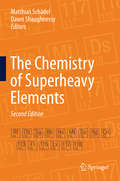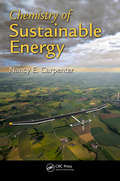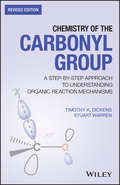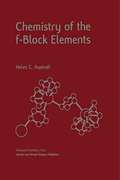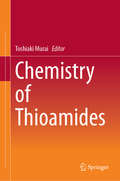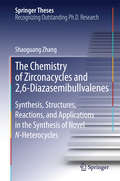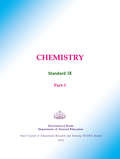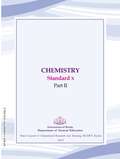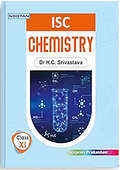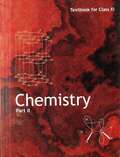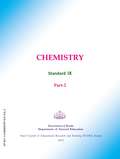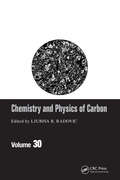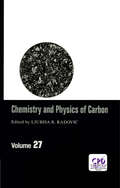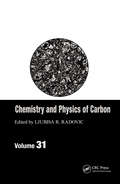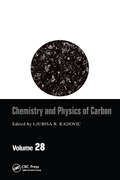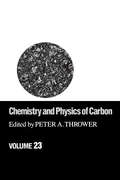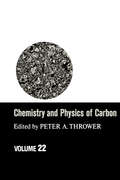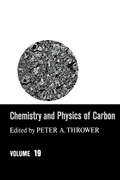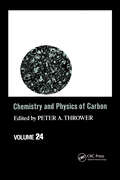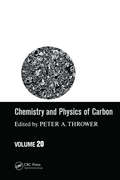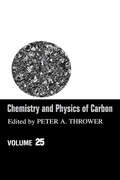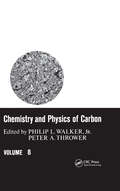- Table View
- List View
The Chemistry of Superheavy Elements
by Matthias Schädel Dawn ShaughnessyThe second edition of "The Chemistry of the Superheavy Elements" provides a complete coverage of the chemistry of a series of elements beginning with atomic number 104 - the transactinides or superheavy elements - including their nuclear properties and production in nuclear reactions at heavy-ion accelerators. The contributors to this work include many renowned scientists who, during the last decades, have made vast contributions towards understanding the physics and chemistry of these elusive elements, both experimentally and theoretically. The main emphasis here is on demonstrating the fascinating studies involved in probing the architecture of the Periodic Table at its uppermost end, where relativistic effects drastically influence chemical properties. All known chemical properties of these elements are described together with the experimental techniques applied to study these short-lived man-made elements one atom-at-a-time. The status of theoretical chemistry and of empirical models is presented as well as aspects of nuclear physics. In addition, one chapter outlines the meanderings in this field from a historical perspective and the search for superheavy elements in Nature.
Chemistry of Sustainable Energy
by Nancy E. CarpenterUnderstanding the chemistry underlying sustainable energy is central to any long-term solution to meeting our future energy needs. Chemistry of Sustainable Energy presents chemistry through the lens of several sustainable energy options, demonstrating the breadth and depth of research being carried out to address issues of sustainability and the gl
Chemistry of the Carbonyl Group: A Step-by-Step Approach to Understanding Organic Reaction Mechanisms
by Stuart Warren Timothy K. DickensTeaches and enables students to build confidence in drawing and manipulating curly arrows, a fundamental skill for all organic chemists This book is an interactive approach to learning about chemistry of the carbonyl group—inviting students to work through its pages with pencil and paper in hand. It educates with the belief that the most effective way to learn is by practice and interaction. With this in mind, the reader is asked to predict what would happen under a specific set of reaction conditions. The book is divided into frames: each frame poses a question and invites the reader to predict what will happen. Subsequent frames give the solution but then pose more questions to develop a theme further. Chemistry of the Carbonyl Group: A Programmed Approach to Organic Reaction Mechanisms, Revised Edition provides a solid grounding in the fundamental reactions of carbonyls. Presented in full colour to enhance the understanding of mechanisms within chemistry, the chapters of this step-by-step guide cover: nucleophilic addition to the carbonyl group; nucleophilic substitution; nucleophilic substitution at the carbonyl group with complete removal of carbonyl oxygen; carbanions and enolisation; and building organic molecules from carbonyl compounds. A must-have book for undergraduate chemists to emphasise understanding in carbonyl group chemistry Goes through all the stages of basic carbonyl chemistry, detailing even the simplest mechanisms A step-by-step learning guide to synthetic chemistry for the first year of a chemistry degree, with all the information needed for independent learning Provides a solid grounding in the fundamental reactions of carbonyls which will inform the understanding of many other organic chemistry reactions Chemistry of the Carbonyl Group: A Programmed Approach to Organic Reaction Mechanisms - Revised Edition is packed with all the information on synthetic chemistry that every first-year student will need in order to learn independently.
Chemistry of the f-Block Elements (Advanced Chemistry Texts Ser. #Vol. 5)
by Helen C. AspinallVisual Spatial Enquiry explores visual and textual ways of working within spatial research. Architects and spatial thinkers from the arts, social sciences and humanities present rich case studies from remote and regional settings in Australia to the suburbs of Los Angeles, and from gallery and university settings to community collaborations in Mongolia. Through these case studies the authors reappraise and reconsider research approaches, methods and processes within and across their fields. In spatial research diagramming can be used as a method to synthesise complex concepts into a succinct picture, whereas metaphors can add the richness of lived experiences. Drawing on the editors' own architectural backgrounds, this volume is organised into three key themes: seeing, doing and making space. In seeing space chapters consider observational research enquiries where developing empathy for the context and topic is as important as gathering concrete data. Doing space explores generative opportunities that inform new and innovative propositions, and making space looks at ways to rethink and reshape spatial and relational settings. Through this volume Creagh and McGann invite readers to find their own understandings of the value and practices of neighbouring fields including planning, geography, ethnography, architecture and art. This exploration will be of value to researchers looking to develop their cross-disciplinary literacy, and to design practitioners looking to enhance and articulate their research skills.
The Chemistry of the Theatre
by Jerzy LimonThis innovative, theoretical work focuses on temporal issues in theatre and the 'chemistry' of theatre - the ways in which a variety of factors in performance combine to make up what we call 'theatre'. Discussing a range of canonical plays, from Shakespeare to Beckett, the book makes a unique contribution to theatre and performance studies.
Chemistry of Thioamides
by Toshiaki MuraiThis book covers whole aspects of the sulfur isologues of amides. Starting from the synthetic methods of thioamides, a range of synthetic applications to the construction of carbon–sulfur and carbon–carbon bonds, to asymmetric reactions, to formation of heterocycles are described. Among the array of thiocarbonyl compounds, thioamides are readily handled in room temperature air. Some of their characteristic features are that the polarity of C=S bonds in thioamides is much smaller than C=O bonds in ordinary amides, that thioamides possess higher HOMO and lower LUMO when compared with those of ordinary amides, and that carbon atoms alpha to the C=S and nitrogen atoms in thioamides are more acidic than those in ordinary amides. Theoretical studies further disclose their features. Thioamides are also used as ligands to a wide variety of metals. Their unique photophysical properties and catalytic activities are described here. Characteristic features of biologically relevant thioamides, e.g., thiopeptides and related compounds, are the final focus of the book.
The Chemistry of Zirconacycles and 2,6-Diazasemibullvalenes
by Shaoguang ZhangIn this thesis, the author introduces two strategies used to construct various types of N-heterocycles, based on the chemistry of zirconacycles and 2,6-diazasemibullvalenes. In the first part, the author presents the development of multi-component cyclization of a zirconacyclobutene-silacyclobutene fused compound, nitriles and unsaturated compounds. These reactions provide synthetically useful methodology for various N-heterocycles such as 3-acyl pyrrole, pyrrolo[3,2-d]pyridazine and dihydropyrroloazepine, which are all difficult to synthesize by other means. The isolation and characterization of the key three-fused-ring Zr/Si-containing intermediates are also described in detail. These results show that the zirconacyclobutene-silacyclobutene fused compound behaves as a "chemical transformer" upon treatment with various substrates via the "coordination-induced skeleton rearrangement" mechanism. In the second part, the author demonstrates the synthesis and isolation of a series of 2,6-diazasemibullvalenes (NSBVs) from the reaction of 1,4-dilithio-1,3-dienes and nitriles, highlighting the significant progress made for the first time in this work: (1) determination of X-ray crystal structure of a substituted 2,6-diazasemibullvalene; (2) measurement of the activation barrier of its rapid intramolecular aza-Cope rearrangement in solution; (3) exploration of several reaction types of NSBV with diverse ring-expansion products and "bowl-shape" or "cage-shape" N-containing polycyclic skeletons; (4) demonstration of the localized structure as the predominant form and the homoaromatic delocalized structure as a minor component in the equilibrium using theoretical analysis. Based on well-founded results, this work sheds new light on this controversial topic.
Chemistry Part 1 class 10 - S.C.E.R.T. - Kerala Board
by State Council of Educational Research TrainingChemistry Part 1 textbook for 10th standard from State Council of Educational Research and Training (S.C.E.R.T.) Kerala in English.
Chemistry Part 1 class 11 - NCERT
by National Council of Educational Research and Trainingchemistry Part-I textbook for the 11th standard from National Council of Educational Research and Training, New Delhi in English.
Chemistry Part 1 class 9 - S.C.E.R.T. - Kerala Board
by State Council of Educational Research TrainingChemistry Part 1 text book for 9th standard from State Council of Educational Research and Training (S.C.E.R.T.) Kerala in English.
Chemistry Part 2 class 10 - S.C.E.R.T. - Kerala Board
by State Council of Educational Research TrainingChemistry Part 2 textbook for 10th standard from State Council of Educational Research and Training (S.C.E.R.T.) Kerala in English.
Chemistry Part-2 class 11 - ISC
by Dr H. C. SrivastavaComputer Fundamentals: Nootan ISC Chemistry for Class XI has been thoroughly revised and restructured in the light of the latest syllabus and the detailed scope of the syllabus issued by the Council for Indian School Certificate Examination, New Delhi. Si
Chemistry Part-2 class 11 - NCERT - 23
by National Council of Educational Research and TrainingIn "Chemistry Part 2" for class 11, Unit 7 delves into Redox Reactions, presenting classical oxidation-reduction concepts and electron transfer dynamics. The unit also introduces oxidation numbers and their link to electrode processes. Transitioning to Organic Chemistry in Unit 8, readers explore the unique tetravalence of carbon, varied organic compound structures, and their classification. The unit demystifies organic compound nomenclature, introduces isomerism, and delves into organic reaction mechanisms. Techniques for purifying and analyzing organic compounds are discussed, encompassing both qualitative and quantitative approaches. Unit 9, centered on Hydrocarbons, classifies them as alkanes, alkenes, alkynes, and aromatic types, concluding with a note on certain hydrocarbons' carcinogenicity and toxicity.
Chemistry Part 2 class 9 - S.C.E.R.T. - Kerala Board
by State Council of Educational Research TrainingChemistry (Part-2) text book for 9th standard from State Council of Educational Research and Training (S.C.E.R.T.) Kerala in English.
Chemistry & Physics of Carbon: Volume 30 (Chemistry and Physics of Carbon)
by Ljubisa R. RadovicWritten by distinguished researchers in carbon, the long-running Chemistry and Physics of Carbon series provides a comprehensive and critical overview of carbon in terms of molecular structure, intermolecular relationships, bulk and surface properties, and their behavior in an amazing variety of current and emerging applications, rang
Chemistry & Physics of Carbon: Volume 27
by Ljubisa R. Radovic"Provides an overview of scientific and technological issues in environmental applications of carbon materials. Emphasizes the versatility of carbon materials in both gas- and liquid-phase environmental applications, including a discussion of emerging technologies. Highlights the power and potential opportunities afforded by NMR spectroscopy for un
Chemistry & Physics of Carbon: Volume 31 (Chemistry and Physics of Carbon)
by Ljubisa R. RadovicWritten by distinguished researchers, the long-running Chemistry and Physics of Carbon series provides a comprehensive and critical overview of carbon materials in terms of molecular structure, intermolecular relationships, bulk and surface properties, and their behavior in current and emerging applications. Volume 31 not only retains the high-qual
Chemistry & Physics of Carbon: Volume 28
by Ljubisa R. RadovicThe Chemistry and Physics of Carbon series presents advances in carbon research and development and comprehensive reviews on the state of the science in all these areas. Building on the tradition of its highly acclaimed predecessors, Volume 28 of this series presents authoritative, interdisciplinary coverage of contemporary topics. With contributio
Chemistry & Physics of Carbon: Volume 23
by Peter A. ThrowerThis book presents authoritative, interdisciplinary coverage of contemporary topics in the field of carbon chemistry and physics and clearly shows the diversity and universality of carbon research. It is useful for readers working in the general area of carbon adsorbents.
Chemistry & Physics of Carbon: Volume 22
by Peter A. ThrowerThis book provides insights into the mechanisms of primary carbonization and reviews the graphitization of various carbon materials under applied pressures. It discusses the changes in the thermal-mechanical properties of carbon/carbon composites due to stress effects.
Chemistry & Physics of Carbon: Volume 19
by Peter A. ThrowerThis volume reviews the evidence for some elements substituting directly for carbon atoms in the graphite lattice. It is an invaluable resource to all carbon researchers and to those who involved with graphite materials, and serves to provoke research.
Chemistry & Physics of Carbon: Volume 24
by Peter A. ThrowerThis 24th volume continues in the tradition of its predecessors, presenting authoritative, interdisciplinary coverage of contemporary topics in the field of carbon chemistry and physics. With contributions by leading international experts, this volume: describes pitch polymerization kinetics during mesophase formation and the constitution of coexisting phases in mesophase pitch during heat treatment; elucidates the mechanism of mesophase formation and pitch polymerization kinetics after mesophase formation; examines the importance of physical, solid-state, electro- and analytical chemistry in the study of carbon surfaces; discusses the theoretical background for the thermal conductivity of diamonds, single crystal diamonds and chemically-vapour-deposited diamond films; and explains the chemistry involved in the commercial fabrication and use of needle coke.
Chemistry & Physics of Carbon: Volume 20 (Chemistry And Physics Of Carbon Ser. #24)
by Peter A. ThrowerThis book provides a fundamental understanding of the basis of the theoretical treatment of electronic properties in graphite. It illustrates the wide range of topics of interest to researchers on carbon materials and stimulates further understanding of some of the phenomena involved.
Chemistry & Physics of Carbon: Volume 25 (Chemistry and Physics of Carbon)
by Peter A. Thrower"Volume 25 introduces methods for the preparation of carbyne and addresses theoretical issues; discusses carbyne properties, spectroscopy, and chemical and crystal structure; explains the use of x-ray and neutron scattering for the structural evaluation of carbonaceous materials; and more."
Chemistry & Physics of Carbon: Volume 8 (Chemistry and Physics of Carbon)
by P. L. Walker Peter A. ThrowerThis book provides a comprehensive and critical overview of carbon materials in terms of molecular structure, intermolecular relationships, bulk and surface properties, and their behavior in current and emerging applications. It also presents advances in carbon research and development.
